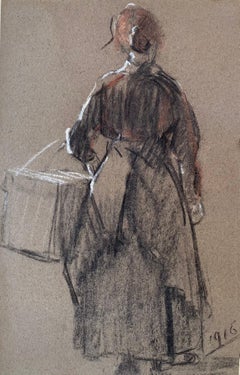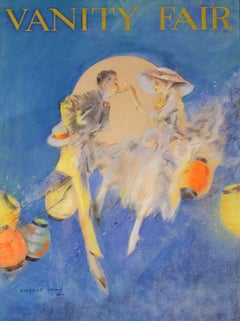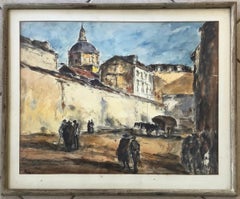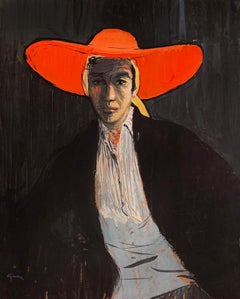Everett Shinn Mixed Media
American, 1876-1953
Everett Shinn, a future member of the Eight and remarkable, rather theatrical personality was born at Woodstown, New Jersey in 1873. Even more recent sources give 1876 as the year of Everett Shinn's birth (Zurier, Snyder, and Mecklenburg, 1995, p. 224) but the artist usually lied about his age to appear younger than he actually was. Edith DeShazo (1974, errata sheet) claimed that information from family members established the date of November 6, 1876 as Shinn's birthday. But if this is true, he would have enrolled at the Spring Garden Institute in Philadelphia to study industrial art at the age of twelve. Born to a Quaker named Isaiah Conklin Shinn and Josephine Ransley Shinn, Everett was their third child. He enjoyed a happy childhood as an undisciplined boy fond of sweets, acrobatics, and the circus (DeShazo, 1974, pp. 15-17).
Shinn opted for the Pennsylvania Academy of the Fine Arts for instruction in the fall of 1893, and began as a staff artist for the Philadelphia Press. At that time William Glackens was working there as well, while John Sloan was at the Inquirer. A year later, Glackens was at the Press, and also, in 1894, George Luks joined the staff there. As DeShazo explained (1974, p. 29), "the Press art department became a meeting place for men both on the staff and off with similar artistic and literary interests." Members of the same group also met at Robert Henri's studio. By 1897, Shinn was in New York, working for the New York World where Luks had been for about a year. The rest of the "Philadelphia Four" (artist-reporters) would follow them before long.
Shinn spent much of 1898 hounding the offices of Harper's until finally, the editor and publisher, Colonel George Harvey saw his portfolio, then commissioned a view of the Old Metropolitan Opera House in a snowstorm. The pastel appeared about a year later in the February 17th issue of Harper's Weekly, in 1900. Meanwhile, Shinn kept busy with decorative work (murals, screens, and door panels) at private residences and even in Trenton, New Jersey's City Hall. In 1899, the Boussod-Valadon Galleries gave Shinn his first one-man show. He continued to carry out commissions for illustrations (see Bullard, 1968). Shinn began exhibiting at the Pennsylvania Academy (1899-1908) and at the Art Institute of Chicago (1903-43).to
1
1
1
Overall Width
to
Overall Height
to
2
2
2
2
2
2
2
2
23
295
265
150
148
2
2
Artist: Everett Shinn
“Headed to Market, 1916”
By Everett Shinn
Located in Southampton, NY
Original drawing of a woman heading to market by the well known American artist, Everett Shinn. Mixed media work created with charcoal, pastel and gouache. Signed with the artist’s initials lower right and dated 1916. Condition is very good. Under glass. Matted and in a period gold frame with restorations. Overall framed measurements are 23.5 by 17.25 inches. Provenance: A New York City estate.
Everett Shinn (1876 – 1953)
Everett Shinn, a realist artist associated with the Ashcan School and member of “The Eight” was born in New Jersey in 1876. After showing an aptitude for the arts as a child, at age 15, Shinn was enrolled at the Spring Garden Institute in Philadelphia. He quickly moved on to classes at the Pennsylvania Academy of the Fine Arts and by the age of 17, he was working as a staff artist for the Philadelphia Press. While working at the Press, Shinn befriended fellow artists William J. Glackens, George Luks, and John Sloan. This group, with Robert Henri and Joseph Laub, established the Charcoal Club, a social and intellectual sort of alternative art school.
In 1897, Shinn moved to New York City to work as an illustrator at the New York World. He became fascinated by the drama of the city. While visiting Europe in 1900, Shinn took interest in the work of the Impressionists, particularly those of Degas. Degas’ influence can be read in Shinn’s depictions of American theater. From his acquaintances in the theater world, Shinn began to paint decorative “rococo revivalist” murals in the homes of the wealthy elite. He also worked extensively in pastel, portraying the rough life of the city. In 1908, Shinn exhibited alongside his Charcoal Club associates, with the addition of Arthur B. Davies, Ernest Lawson, and Maurice Prendergast...
Category
1910s Ashcan School Everett Shinn Mixed Media
Materials
Charcoal, Pastel, Gouache
$3,360 Sale Price
20% Off
Couple Sitting Among Lanterns, Cover for Vanity Fair
By Everett Shinn
Located in Fort Washington, PA
Medium: Pastel, Gouache, and Black Crayon on Paperboard
Sight Size 22.88" x 17.50", Framed 31.75" x 26.50"
Signature: Signed EVERETT SHINN and Dated
Vanity Fair Cover...
Category
1910s Everett Shinn Mixed Media
Materials
Crayon, Pastel, Gouache, Board
Related Items
Arturo Souto Feijoo (1901-1964) City Walls w/ Figures Original Mixed Media c.195
Located in San Francisco, CA
Arturo Souto Feijoo (1901-1964) City Walls w/ Figures Original Mixed Media c.1950
Original pastel, watercolor and charcoal on paper. Housed in a simple f...
Category
Mid-20th Century Impressionist Everett Shinn Mixed Media
Materials
Charcoal, Pastel, Watercolor
$1,800
H 27 in W 33 in D 2 in
Figure in a Wide-brimmed Red Hat
By René Gruau
Located in Miami, FL
Elegant and graphic study of a figure of undetermined gender. It's executed with quick and confident brush strokes in the artist's signature color scheme of black and red. It's a fla...
Category
1960s Contemporary Everett Shinn Mixed Media
Materials
Pastel, Mixed Media, Gouache, Board
Framed Art Nouveau Period Painting A Greek Love Affair Theseus And Ariadne
By Antoine Calbet
Located in Sutton Poyntz, Dorset
Follower of Antoine Calbet.
French ( b.1860 - d.1944 ).
Theseus and Ariadne, Circa 1890 - 1910.
Mixed Media.
Watercolour, Gouache & Pastel
Image size 16.5 inches x 11.2 inches ( 42cm...
Category
Early 1900s Art Nouveau Everett Shinn Mixed Media
Materials
Pastel, Gouache, Watercolor, Paper
$1,737
H 18.51 in W 13.39 in D 0.89 in
Sailors in the Port of Nice
By Alfred Salvignol
Located in London, GB
'Sailors in the Port of Nice', mixed media - gouache, pastel and oil on paper, by Alfred Salvignol (circa 1950s). The Port of Nice is one of the key hubs of Nice and, in fact, of the entire French Riviera, standing out as one of the main harbours for the boats which sail across the Mediterranean Sea. It accommodates both the ships operated by ferry companies and the private yachts of visitors who come to Nice by sea. The artist here depicts a group of crusty sailors watching...
Category
1950s Expressionist Everett Shinn Mixed Media
Materials
Paper, Pastel, Oil, Gouache
Still life , 65x50cm, paper/ pastel/ gouache
By Aleksandra Mato
Located in Yerevan, AM
Still life
Category
2010s Contemporary Everett Shinn Mixed Media
Materials
Paper, Pastel, Gouache
$750 Sale Price
25% Off
H 25.6 in W 19.69 in
Still life , 65x50cm, paper/ pastel/ gouache
By Aleksandra Mato
Located in Yerevan, AM
Still life
Category
2010s Contemporary Everett Shinn Mixed Media
Materials
Paper, Pastel, Gouache
$750 Sale Price
25% Off
H 25.6 in W 19.69 in
Model in the Studio - Figurative in Gouache and Pastel on Paper
Located in Soquel, CA
Evocative figurative painting of a woman seated in a studio by an unknown artist (20th Century). A woman dressed in red is sitting in a chair atop a platform. There are studio lights...
Category
Early 2000s American Impressionist Everett Shinn Mixed Media
Materials
Paper, Pastel, Gouache
The Pavement #2 - Original Colorful Quirky Urban Figurative Mixed Media Artwork
By Fabio Coruzzi
Located in Los Angeles, CA
Italian artist Fabio Coruzzi merges painting and photography into one imaginative image that offers a new outlook on an otherwise ordinary urban scene. His artworks represent an auth...
Category
21st Century and Contemporary Pop Art Everett Shinn Mixed Media
Materials
Paper, Oil Pastel, Pastel, Mixed Media, Acrylic, Wood, Cardboard, Gel Pen
Post Impressionist Garden View, Lady Picking Flowers, Circle of Edouard Vuillard
By Edouard Vuillard
Located in Cotignac, FR
1920s Garden view, mixed medium on paper, influenced by the garden paintings of Vuillard from the same period. The work is indistinctly signed, as yet undeciphered, bottom right. Pre...
Category
Early 20th Century Post-Impressionist Everett Shinn Mixed Media
Materials
Oil Crayon, Pastel, Gouache
$1,155
H 15.36 in W 20.28 in D 0.79 in
Rare Modernist Hungarian Rabbi Pastel Drawing Gouache Painting Judaica Art Deco
By Hugó Scheiber
Located in Surfside, FL
Rabbi in the synagogue at prayer wearing tallit and tefillin.
Hugó Scheiber (born 29 September 1873 in Budapest – died there 7 March 1950) was a Hungarian modernist painter.
Hugo Scheiber was brought from Budapest to Vienna at the age of eight where his father worked as a sign painter for the Prater Theater. At fifteen, he returned with his family to Budapest and began working during the day to help support them and attending painting classes at the School of Design in the evening, where Henrik Papp was one of his teachers. He completed his studies in 1900. His work was at first in a post-Impressionistic style but from 1910 onward showed his increasing interest in German Expressionism and Futurism. This made it of little interest to the conservative Hungarian art establishment.
However, in 1915 he met the great Italian avant-gardist Filippo Tommaso Marinetti and the two painters became close friends. Marinetti invited him to join the Futurist Movement. The uniquely modernist style that he developed was, however, closer to German Expressionism than to Futurism and eventually drifted toward an international art deco manner similar to Erté's. In 1919, he and his friend Béla Kádar held an exhibition at the Hevesy Salon in Vienna. It was a great success and at last caused the Budapest Art Museum to acquire some of Scheiber's drawings. Encouraged, Scheiber came back to live in Vienna in 1920.
A turning point in Scheiber's career came a year later, when Herwarth Walden, founder of Germany's leading avant-garde periodical, Der Sturm, and of the Sturm Gallery in Berlin, became interested in Scheiber's work. Scheiber moved to Berlin in 1922, and his paintings soon appeared regularly in Walden's magazine and elsewhere. Exhibitions of his work followed in London, Rome, La Paz, and New York.
Scheiber's move to Germany coincided with a significant exodus of Hungarian artists to Berlin, including Laszlo Moholy-Nagy and Sandor Bortnyik. There had been a major split in ideology among the Hungarian avant-garde. The Constructivist and leader of the Hungarian avantgarde, Lajos Kassák (painted by Hugó Scheiber in 1930) believed that art should relate to all the needs of contemporary humankind. Thus he refused to compromise the purity of his style to reflect the demands of either the ruling class or socialists and communists. The other camp believed that an artist should be a figurehead for social and political change.
The fall out and factions that resulted from this politicisation resulted in most of the Hungarian avant gardists leaving Vienna for Berlin. Hungarian émigrés made up one of the largest minority groups in the German capital and the influx of their painters had a significant effect on Hungarian and international art. Another turning point of Scheiber's career came in 1926, with the New York exhibition of the Société Anonyme, organized by Katherine Dreier. Scheiber and other important avant garde artists from more than twenty-three countries were represented. In 1933, Scheiber was invited by Marinetti to participate in the great meeting of the Futurists held in Rome in late April 1933, Mostra Nazionale d’Arte Futurista where he was received with great enthusiasm. Gradually, the Hungarian artists began to return home, particularly with the rise of Nazism in Germany. Kádar went back from Berlin in about 1932 and Scheiber followed in 1934.
He was then at the peak of his powers and had a special flair in depicting café and cabaret life in vivid colors, sturdily abstracted forms and spontaneous brush strokes. Scheiber depicted cosmopolitan modern life using stylized shapes and expressive colors. His preferred subjects were cabaret and street scenes, jazz musicians, flappers, and a series of self-portraits (usually with a cigar). his principal media being gouache and oil. He was a member of the prestigious New Society of Artists (KUT—Képzőművészek Új Társasága)and seems to have weathered Hungary's post–World War II transition to state-communism without difficulty. He continued to be well regarded, eventually even receiving the posthumous honor of having one of his images used for a Russian Soviet postage stamp (see image above). Hugó Scheiber died in Budapest in 1950.
Paintings by Hugó Scheiber form part of permanent museum collections in Budapest (Hungarian National Museum), Pecs (Jannus Pannonius Museum), Vienna, New York, Bern and elsewhere. His work has also been shown in many important exhibitions, including:
"The Nell Walden Collection," Kunsthaus Zürich (1945)
"Collection of the Société Anonyme," Yale University Art Gallery, New Haven, Connecticut (1950)
"Hugó Scheiber: A Commemorative Exhibition," Hungarian National Museum, Budapest (1964)
"Ungarische Avantgarde," Galleria del Levante, Munich (1971)
"Paris-Berlin 1900-1930," Centre Georges Pompidou, Paris (1978)
"L’Art en Hongrie, 1905-1920," Musée d’Art et l’Industrie, Saint-Etienne (1980)
"Ungarische Avantgarde in der Weimarer Republik," Marburg (1986)
"Modernizmus," Eresz & Maklary Gallery, Budapest (2006)
"Hugó Scheiber & Béla Kádár," Galerie le Minotaure, Paris and Tel Aviv (2007)
Hugó Scheiber's paintings continue to be regularly sold at Sotheby's, Christie's, Gillen's Arts (London), Papillon Gallery (Los Angeles) and other auction houses.
He was included in the exhibition The Art Of Modern Hungary 1931 and other exhibitions along with Vilmos Novak Aba, Count Julius Batthyany, Pal Bor, Bela Buky, Denes Csanky, Istvan Csok, Bela Czobel, Peter Di Gabor, Bela Ivanyi Grunwald, Baron Ferenc Hatvany, Lipot Herman, Odon Marffy, C. Pal Molnar...
Category
Early 20th Century Modern Everett Shinn Mixed Media
Materials
Paper, Charcoal, Pastel, Watercolor, Gouache
$5,500
H 15.75 in W 14.5 in
Mixed Media on Fabriano Painting "Simply Ask"
By Anushka Kempken
Located in Cape Town, ZA
The artwork is framed and floated to the backboard. The dimensions of 44 x 50 cm are that of the artwork only, excluding the size of the frame.
Category
2010s Contemporary Everett Shinn Mixed Media
Materials
Gold Leaf
$848 Sale Price
20% Off
H 17.33 in W 19.69 in D 1.58 in
Blond Pin up with Perfect Smile Tennis Racket - Women Illustrators
Located in Miami, FL
Julia (Elsie Julia Miller) Schleicher (Canadian/American, 1916-1988)
she was an important female illustrator
Woman Tennis Player
Pastel and gouache on boa...
Category
1940s Romantic Everett Shinn Mixed Media
Materials
Pastel, Gouache
$8,000
H 18 in W 13.6 in D 1 in
Everett Shinn mixed media for sale on 1stDibs.
Find a wide variety of authentic Everett Shinn mixed media available for sale on 1stDibs. If you’re browsing the collection of mixed media to introduce a pop of color in a neutral corner of your living room or bedroom, you can find work that includes elements of purple and other colors. You can also browse by medium to find art by Everett Shinn in crayon, gouache, paint and more. Not every interior allows for large Everett Shinn mixed media, so small editions measuring 8 inches across are available. Everett Shinn mixed media prices can differ depending upon medium, time period and other attributes. On 1stDibs, the price for these items starts at $4,200 and tops out at $169,000, while the average work can sell for $86,600.
Questions About Everett Shinn Mixed Media
- Why is Everett Shinn famous?1 Answer1stDibs ExpertJanuary 27, 2025Everett Shinn is famous for his paintings and because he was an important member of the Eight, a group of artists who produced Urban Realist works during the early 20th century. Some of his most notable works include The White Ballet, Spanish Music Hall, Keith's Union Square and Revue. Explore a range of Everett Shinn art on 1stDibs.



